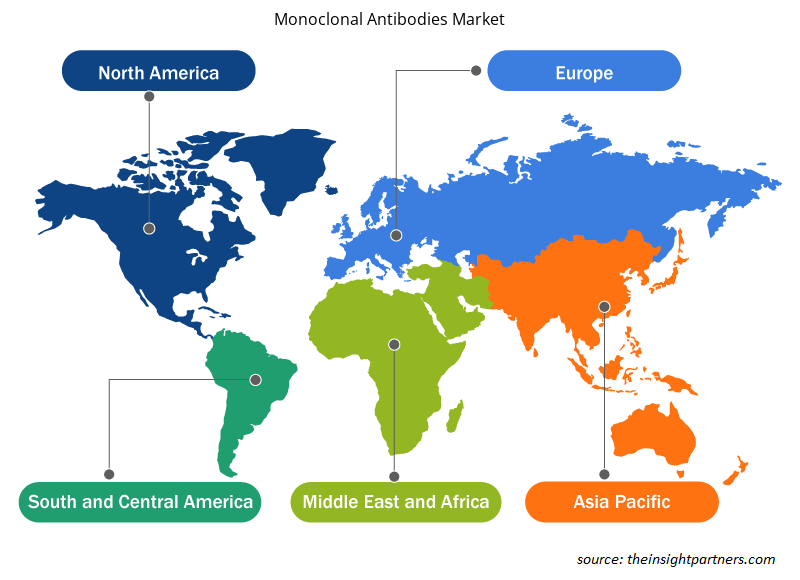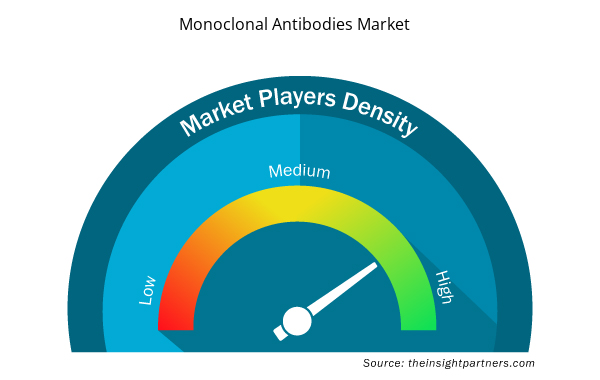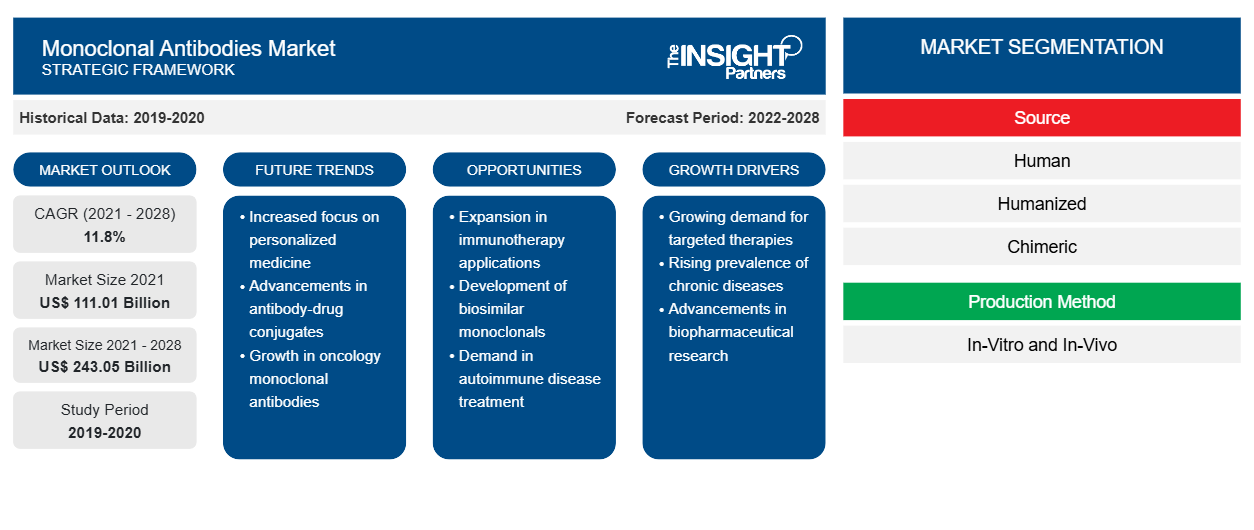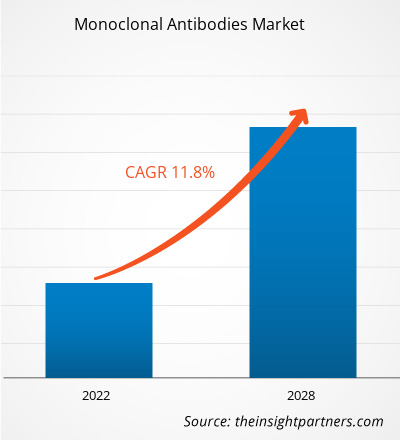Le marché des anticorps monoclonaux devrait atteindre 243,05 milliards de dollars américains d'ici 2028, contre 111,01 milliards de dollars américains en 2021 ; il devrait croître à un TCAC de 11,8 % de 2021 à 2028.TCAC de 11,8 % de 2021 à 2028.
La prévalence croissante du cancer et d'autres maladies chroniques, ainsi que l'augmentation considérable des cas de COVID-19 dans diverses régions sont les principaux facteurs qui alimentent la croissance du marché. Selon le World Cancer Research Fund et l'American Institute for Cancer, en 2020, environ 18,1 millions de cas de cancer ont été enregistrés, dont 9,3 millions chez les hommes et 8,8 millions chez les femmes. L'utilisation d'anticorps monoclonaux dans le traitement de divers types de cancer en est encore aux essais de phase 2 et de phase 3.
L'Amérique du Nord devrait continuer à dominer le marché des anticorps monoclonaux au cours de la période 2021-2028. Les États-Unis détiennent la plus grande part du marché dans cette région et devraient continuer à être un actionnaire dominant du marché au cours de la période de prévision. Selon les statistiques publiées par Globocan 2020, environ 1 806 590 nouveaux cas de cancer ont été diagnostiqués aux États-Unis et environ 606 520 personnes sont décédées des suites de cette maladie. Selon un rapport du ministère américain du Commerce, son National Institute of Standards and Technology (NIST) a annoncé le financement de 153 millions de dollars américains au National Institute for Innovation in Manufacturing Biopharmaceuticals. En outre, la FDA a étendu son soutien au développement d'anticorps monoclonaux pendant la prévalence du COVID-19.En 2020, environ 1 806 590 nouveaux cas de cancer ont été diagnostiqués aux États-Unis et environ 606 520 personnes sont décédées des suites de cette maladie. Selon un rapport du ministère américain du Commerce, son National Institute of Standards and Technology ( NIST ) a annoncé le financement de 153 millions de dollars américains au National Institute for Innovation in Manufacturing Biopharmaceuticals . En outre, la FDA a étendu son soutien au développement d'anticorps monoclonaux pendant la pandémie de COVID-19.
Personnalisez ce rapport en fonction de vos besoins
Vous bénéficierez d'une personnalisation gratuite de n'importe quel rapport, y compris de certaines parties de ce rapport, d'une analyse au niveau des pays, d'un pack de données Excel, ainsi que d'offres et de remises exceptionnelles pour les start-ups et les universités.
- Obtenez les principales tendances clés du marché de ce rapport.Cet échantillon GRATUIT comprendra une analyse de données, allant des tendances du marché aux estimations et prévisions.
Informations sur le marché
L'augmentation significative de la prévalence du cancer et d'autres maladies chroniques stimule la croissance du marché
Selon le rapport de l'American Cancer Society, environ 16,9 millions de personnes ayant des antécédents de cancer résidaient aux États-Unis en janvier 2019. D'ici janvier 2030, la population de survivants du cancer devrait atteindre 22,1 millions en raison de la croissance et du vieillissement de la population. Par conséquent, avec la prévalence croissante du cancer et d'autres maladies chroniques, la demande de produits biologiques, tels que les anticorps monoclonaux (mAB), a également augmenté. En tant que composants principaux de nombreux schémas thérapeutiques et traitements rentables, les produits biologiques jouent un rôle clé dans le traitement du cancer.
Informations basées sur des sources
Selon la source, le marché des anticorps monoclonaux est segmenté en murin, chimérique, humain et humanisé. Le segment humain devrait représenter la plus grande part de marché au cours de la période 2021-2028. La croissance du marché de ce segment est attribuée à la hausse due à l'intégration d'anticorps monoclonaux humains pour le traitement de divers types de maladies infectieuses . Par exemple, Regeneron a lancé un cocktail d'anticorps approuvé par la FDA, casirivimab et imdevimab, pour une utilisation dans le COVID-19. Le médicament a reçu une autorisation d'utilisation d'urgence (EUA) de la FDA. Il est utilisé pour le traitement du COVID-19 léger à modéré chez les adultes ainsi que chez les patients pédiatriques âgés d'au moins 12 ans et pesant au moins 40 kg. De plus, l'augmentation de leur utilisation dans diverses maladies chroniques et l'emploi de technologies avancées de génie génétique comptent parmi les facteurs importants qui stimulent la croissance du segment de marché.
Informations basées sur des indications
Selon les indications, le cancer, les maladies auto-immunes, les maladies inflammatoires , les maladies infectieuses, les maladies microbiennes et autres. Le segment du cancer dominera le marché dans les années à venir. Les progrès liés à l'application thérapeutique des anticorps monoclonaux ont permis leur mise en œuvre réussie dans les traitements de divers types de cancer, tels que le cancer du sein, le cancer du poumon et le cancer du côlon. Les médicaments à base de ces anticorps aident à signaler les cellules cancéreuses, à déclencher la destruction de la membrane cellulaire, à bloquer les inhibiteurs du système immunitaire, etc. En juin 2020, la FDA a approuvé deux médicaments, l'olaparib et le rucaparib, pour le traitement du cancer de la prostate. Le médicament est particulièrement efficace chez les hommes atteints de cancer de la prostate qui se sont propagés ou métastasés et qui ne répondent plus aux traitements hormonaux standard, c'est-à-dire les maladies résistantes à la castration.
Informations basées sur l'utilisateur final
Le marché des anticorps monoclonaux est segmenté en fonction de l'utilisateur final : hôpitaux, instituts de recherche et autres. Le segment hospitalier détient la plus grande part de marché en raison de l'adoption croissante des mAB comme ligne de traitement privilégiée, en particulier pour le traitement du cancer.
Les entreprises opérant sur le marché des anticorps monoclonaux adoptent la stratégie d’innovation produit pour répondre aux demandes évolutives des clients à travers le monde, ce qui leur permet également de maintenir leur nom de marque sur le marché mondial.
Aperçu régional du marché des anticorps monoclonaux
Les tendances régionales et les facteurs influençant le marché des anticorps monoclonaux tout au long de la période de prévision ont été expliqués en détail par les analystes d’Insight Partners. Cette section traite également des segments et de la géographie du marché des anticorps monoclonaux en Amérique du Nord, en Europe, en Asie-Pacifique, au Moyen-Orient et en Afrique, ainsi qu’en Amérique du Sud et en Amérique centrale.

- Obtenez les données régionales spécifiques au marché des anticorps monoclonaux
Portée du rapport sur le marché des anticorps monoclonaux
| Attribut de rapport | Détails |
|---|---|
| Taille du marché en 2021 | 111,01 milliards de dollars américains |
| Taille du marché d'ici 2028 | 243,05 milliards de dollars américains |
| Taux de croissance annuel moyen mondial (2021-2028) | 11,8% |
| Données historiques | 2019-2020 |
| Période de prévision | 2022-2028 |
| Segments couverts | Par source
|
| Régions et pays couverts | Amérique du Nord
|
| Leaders du marché et profils d'entreprises clés |
|
Densité des acteurs du marché des anticorps monoclonaux : comprendre son impact sur la dynamique commerciale
Le marché des anticorps monoclonaux connaît une croissance rapide, tirée par la demande croissante des utilisateurs finaux en raison de facteurs tels que l'évolution des préférences des consommateurs, les avancées technologiques et une plus grande sensibilisation aux avantages du produit. À mesure que la demande augmente, les entreprises élargissent leurs offres, innovent pour répondre aux besoins des consommateurs et capitalisent sur les tendances émergentes, ce qui alimente davantage la croissance du marché.
La densité des acteurs du marché fait référence à la répartition des entreprises ou des sociétés opérant sur un marché ou un secteur particulier. Elle indique le nombre de concurrents (acteurs du marché) présents sur un marché donné par rapport à sa taille ou à sa valeur marchande totale.
Les principales entreprises opérant sur le marché des anticorps monoclonaux sont :
- Novartis SA
- Pfizer Inc.
- GlaxoSmithKline plc
- Amgen, Inc
- Société Daiichi Sankyo, Limitée
Avis de non-responsabilité : les sociétés répertoriées ci-dessus ne sont pas classées dans un ordre particulier.

- Obtenez un aperçu des principaux acteurs du marché des anticorps monoclonaux
Marché des anticorps monoclonaux – Segmentation
Selon la source, le marché des anticorps monoclonaux est segmenté en humains, humanisés, chimériques et murins. Selon la méthode de production, le marché est segmenté en in vitro et in vivo. Le marché des anticorps monoclonaux, par indication, est en outre segmenté en cancer, maladies auto-immunes, maladies infectieuses, maladies inflammatoires, maladies microbiennes et autres. Par application, le marché est sous-segmenté en applications thérapeutiques, applications diagnostiques et applications de recherche. De plus, en fonction de l'utilisateur final, le marché est segmenté en hôpitaux, autres et instituts de recherche.
Marché des anticorps monoclonaux – par géographie
- Amérique du Nord
- NOUS
- Canada
- Mexique
- Europe
- France
- Allemagne
- Italie
- ROYAUME-UNI
- Espagne
- Reste de l'Europe
- Asie-Pacifique (APAC)
- Chine
- Inde
- Corée du Sud
- Japon
- Australie
- Reste de l'APAC
- Moyen-Orient et Afrique (MEA)
- Afrique du Sud
- Arabie Saoudite
- Émirats arabes unis
- Reste de la MEA
- Amérique du Sud et Amérique centrale (SCAM)
- Brésil
- Argentine
- Reste de SCAM
Profils d'entreprise
- Novartis SA
- Pfizer Inc.
- GlaxoSmithKline plc
- Amgen, Inc
- Société Daiichi Sankyo, Limitée
- F. Hoffmann-La Roche AG
- AstraZeneca
- Elli Lily et compagnie
- Bayer AG
- Société Bristol-Myers Squibb
- Analyse historique (2 ans), année de base, prévision (7 ans) avec TCAC
- Analyse PEST et SWO
- Taille du marché Valeur / Volume - Mondial, Régional, Pays
- Industrie et paysage concurrentiel
- Ensemble de données Excel



Report Coverage
Revenue forecast, Company Analysis, Industry landscape, Growth factors, and Trends

Segment Covered
This text is related
to segments covered.

Regional Scope
North America, Europe, Asia Pacific, Middle East & Africa, South & Central America

Country Scope
This text is related
to country scope.
Questions fréquemment posées
Significant rise in the cancer and chronic diseases is one of the most significant factors responsible for the overall market growth.
Based on source, human segment took the forefront lead in the worldwide market by accounting largest share in 2020 and is expected to continue to do so till the forecast period.
Food and Drug Administration (FDA) defines monoclonal antibodies as immunoglobulin molecules that are secreted from a population of identical cells. They are homogenous in structure and binding specificity. These are used as multifunctional components for the immune system. They facilitate numerous cellular and humoral reactions to a variety of antigens, which include host and foreign substances.
The in vitro segment dominated the global monoclonal antibodies market and accounted for the largest revenue of 75,044.50 Mn in 2021.
Global monoclonal antibodies market is segmented by region into North America, Europe, Asia Pacific, Middle East & Africa, and South & Central America. In North America, the U.S. is the largest market for monoclonal antibodies market. The US is estimated to hold the largest share in the monoclonal antibodies market during the forecast period. The presence of top players and favorable regulations related to product approvals coupled with commercializing new products are the contributing factors for the regional growth. Additionally, the increasing number of R&D activities is the key factor responsible for the Asia-Pacific regional growth for monoclonal antibodies accounting fastest growth of the region during the coming years.
Novartis AG, Pfizer, Inc., GlaxoSmithKline Plc, Amgen, Inc., Daiichi Sankyo Company, Limited, F.Hoffmann-La Roche AG, AstraZeneca, Elli Lilly and Company, Bayer AG, Bristol-Myers Squibb Company are among the leading companies operating in the global monoclonal antibodies market
Trends and growth analysis reports related to Life Sciences : READ MORE..
The List of Companies - Monoclonal Antibody Market
- Novartis AG
- Pfizer Inc.
- GlaxoSmithKline plc
- Amgen, Inc
- Daiichi Sankyo Company, Limited
- F. Hoffmann-La Roche AG
- AstraZeneca
- Elli Lilly and Company
- Bayer AG
- Bristol-Myers Squibb Company
The Insight Partners performs research in 4 major stages: Data Collection & Secondary Research, Primary Research, Data Analysis and Data Triangulation & Final Review.
- Data Collection and Secondary Research:
As a market research and consulting firm operating from a decade, we have published and advised several client across the globe. First step for any study will start with an assessment of currently available data and insights from existing reports. Further, historical and current market information is collected from Investor Presentations, Annual Reports, SEC Filings, etc., and other information related to company’s performance and market positioning are gathered from Paid Databases (Factiva, Hoovers, and Reuters) and various other publications available in public domain.
Several associations trade associates, technical forums, institutes, societies and organization are accessed to gain technical as well as market related insights through their publications such as research papers, blogs and press releases related to the studies are referred to get cues about the market. Further, white papers, journals, magazines, and other news articles published in last 3 years are scrutinized and analyzed to understand the current market trends.
- Primary Research:
The primarily interview analysis comprise of data obtained from industry participants interview and answers to survey questions gathered by in-house primary team.
For primary research, interviews are conducted with industry experts/CEOs/Marketing Managers/VPs/Subject Matter Experts from both demand and supply side to get a 360-degree view of the market. The primary team conducts several interviews based on the complexity of the markets to understand the various market trends and dynamics which makes research more credible and precise.
A typical research interview fulfils the following functions:
- Provides first-hand information on the market size, market trends, growth trends, competitive landscape, and outlook
- Validates and strengthens in-house secondary research findings
- Develops the analysis team’s expertise and market understanding
Primary research involves email interactions and telephone interviews for each market, category, segment, and sub-segment across geographies. The participants who typically take part in such a process include, but are not limited to:
- Industry participants: VPs, business development managers, market intelligence managers and national sales managers
- Outside experts: Valuation experts, research analysts and key opinion leaders specializing in the electronics and semiconductor industry.
Below is the breakup of our primary respondents by company, designation, and region:

Once we receive the confirmation from primary research sources or primary respondents, we finalize the base year market estimation and forecast the data as per the macroeconomic and microeconomic factors assessed during data collection.
- Data Analysis:
Once data is validated through both secondary as well as primary respondents, we finalize the market estimations by hypothesis formulation and factor analysis at regional and country level.
- Macro-Economic Factor Analysis:
We analyse macroeconomic indicators such the gross domestic product (GDP), increase in the demand for goods and services across industries, technological advancement, regional economic growth, governmental policies, the influence of COVID-19, PEST analysis, and other aspects. This analysis aids in setting benchmarks for various nations/regions and approximating market splits. Additionally, the general trend of the aforementioned components aid in determining the market's development possibilities.
- Country Level Data:
Various factors that are especially aligned to the country are taken into account to determine the market size for a certain area and country, including the presence of vendors, such as headquarters and offices, the country's GDP, demand patterns, and industry growth. To comprehend the market dynamics for the nation, a number of growth variables, inhibitors, application areas, and current market trends are researched. The aforementioned elements aid in determining the country's overall market's growth potential.
- Company Profile:
The “Table of Contents” is formulated by listing and analyzing more than 25 - 30 companies operating in the market ecosystem across geographies. However, we profile only 10 companies as a standard practice in our syndicate reports. These 10 companies comprise leading, emerging, and regional players. Nonetheless, our analysis is not restricted to the 10 listed companies, we also analyze other companies present in the market to develop a holistic view and understand the prevailing trends. The “Company Profiles” section in the report covers key facts, business description, products & services, financial information, SWOT analysis, and key developments. The financial information presented is extracted from the annual reports and official documents of the publicly listed companies. Upon collecting the information for the sections of respective companies, we verify them via various primary sources and then compile the data in respective company profiles. The company level information helps us in deriving the base number as well as in forecasting the market size.
- Developing Base Number:
Aggregation of sales statistics (2020-2022) and macro-economic factor, and other secondary and primary research insights are utilized to arrive at base number and related market shares for 2022. The data gaps are identified in this step and relevant market data is analyzed, collected from paid primary interviews or databases. On finalizing the base year market size, forecasts are developed on the basis of macro-economic, industry and market growth factors and company level analysis.
- Data Triangulation and Final Review:
The market findings and base year market size calculations are validated from supply as well as demand side. Demand side validations are based on macro-economic factor analysis and benchmarks for respective regions and countries. In case of supply side validations, revenues of major companies are estimated (in case not available) based on industry benchmark, approximate number of employees, product portfolio, and primary interviews revenues are gathered. Further revenue from target product/service segment is assessed to avoid overshooting of market statistics. In case of heavy deviations between supply and demand side values, all thes steps are repeated to achieve synchronization.
We follow an iterative model, wherein we share our research findings with Subject Matter Experts (SME’s) and Key Opinion Leaders (KOLs) until consensus view of the market is not formulated – this model negates any drastic deviation in the opinions of experts. Only validated and universally acceptable research findings are quoted in our reports.
We have important check points that we use to validate our research findings – which we call – data triangulation, where we validate the information, we generate from secondary sources with primary interviews and then we re-validate with our internal data bases and Subject matter experts. This comprehensive model enables us to deliver high quality, reliable data in shortest possible time.


 Obtenez un échantillon gratuit pour ce rapport
Obtenez un échantillon gratuit pour ce rapport